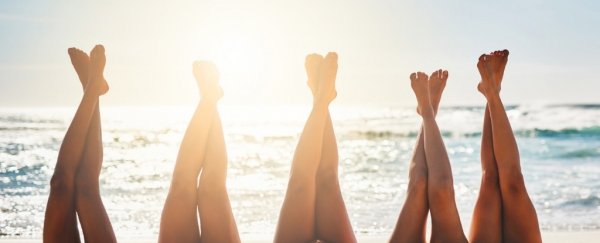If you keep up with wellness trends, you might have heard of something called "perineum sunning".
If you haven't, it's just what it sounds like. It involves going outside undressed — at least on the bottom half — and positioning yourself in a way that exposes your perineum to the sun for a short time.
The perineum is the area between the genitals and anus — so between the anus and the vulva in females, and between the anus and the scrotum in males. It's not a part of our bodies that usually sees the light of day.
While the proponents of this trend talk about all sorts of benefits, there's no evidence for it. It may well do no harm — or you could find yourself with a nasty case of sunburn.
Where does the idea come from?
Perineum sunning is said to have roots in an ancient Taoist practice, where the perineum, or "Hui Yin", is regarded as a gateway where energy enters and exits the body.
It's probably also related to the idea that the sun has healing powers. Many years ago sun exposure was recommended after childbirth, and sunlamps were used in labour wards to ostensibly aid healing. But there was no evidence for this.
Some of the appeal of the trend might also lie in the fact many pale-skinned people like to be tanned.
That said, tanning is not the motivation behind the perineum sunning wellness trend. People who do it say it gives their body an intense dose of vitamin D, and therefore a significant energy boost.
It can also supposedly increase creativity, improve sleep, and even promote a healthy libido, among other reported benefits.
But there's no evidence to support any of these supposed benefits. Although there have been no scientific studies on perineum sunning to date, I would be very surprised if any future research did reveal any notable benefits.
However, we can't dismiss the placebo effect. For example, if someone thinks sunning their perineum will improve their libido, it probably will.
Is it safe?
The main risk of perineum sunning is sunburn. Sun-exposed skin adapts to exposure to ultraviolet (UV) light by forming melanin, the natural protective pigment in skin that reduces the risk of sunburn.
So when you get UV light on a part of your skin that's not accustomed to sun exposure, you're much more likely to get burnt.
If you do get sunburnt in this sensitive area, it's likely to be very sore. You won't be able to have sex for about a week, and it might sting to urinate.
And of course, UV is a known carcinogen, which is why nowadays we discourage any kind of tanning. Sunburn can increase your risk of skin cancer, and chronic UV exposure can raise skin cancer risk even without causing sunburn.
You would have to do an awful lot of perineum sunning to get skin cancer from it. However, there are other potential carcinogens that affect that area, such as oncogenic human papillomavirus genotypes (HPV).
In general, the more carcinogens you're exposed to, the greater the risk.
If you're carrying another possible carcinogen like HPV — statistics suggest HPV is present in up to 70 percent of sexually active people (though this doesn't mean they all have the oncogenic types, with the potential to cause cancer) — this could theoretically increase your risk from perineum sunning.
So what's the take-home message?
If you try perineum sunning on the odd occasion for a couple of minutes, it's probably not dangerous. And there's nothing to say you can't put sunscreen on your perineum if you want to be safer about it.
In terms of following radical health claims, there are worse things you could do, like drinking bleach or buying one of Pete Evans' "BioCharger" machines.
But still, I wouldn't recommend perineum sunning. I don't think it has any benefit, and it does carry some degree of risk.
If you're looking to feel more energised, there are plenty of other tactics to try. Ensure you get enough sleep, exercise regularly, eat healthy food, avoid smoking, limit recreational drugs, moderate your alcohol intake, and stay out of the sun.
These are the sorts of things wellness is about, if you look at it from the perspective of science.
At the end of the day, there's no magic way to boost your energy. And sticking your perineum in the sun is not going to be the answer.
Gayle Fischer, Professor of Dermatology, University of Sydney.
This article is republished from The Conversation under a Creative Commons license. Read the original article.
